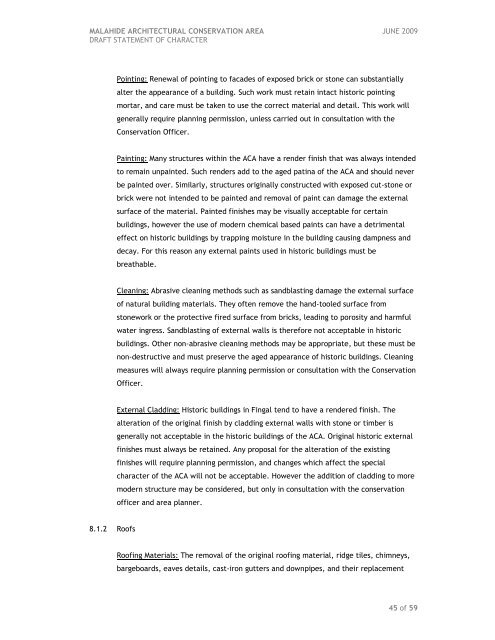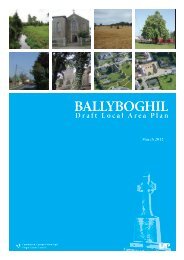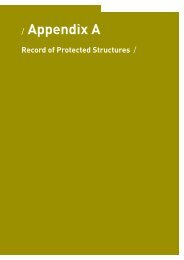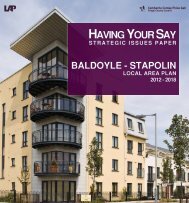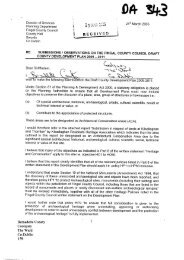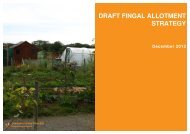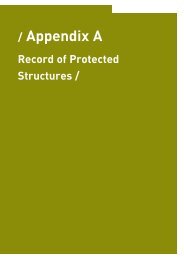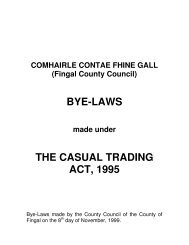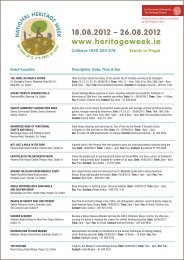DRAFT Malahide Historic Core ACA Statement of Character
DRAFT Malahide Historic Core ACA Statement of Character
DRAFT Malahide Historic Core ACA Statement of Character
Create successful ePaper yourself
Turn your PDF publications into a flip-book with our unique Google optimized e-Paper software.
MALAHIDE ARCHITECTURAL CONSERVATION AREA JUNE 2009<br />
<strong>DRAFT</strong> STATEMENT OF CHARACTER<br />
Pointing: Renewal <strong>of</strong> pointing to facades <strong>of</strong> exposed brick or stone can substantially<br />
alter the appearance <strong>of</strong> a building. Such work must retain intact historic pointing<br />
mortar, and care must be taken to use the correct material and detail. This work will<br />
generally require planning permission, unless carried out in consultation with the<br />
Conservation Officer.<br />
Painting: Many structures within the <strong>ACA</strong> have a render finish that was always intended<br />
to remain unpainted. Such renders add to the aged patina <strong>of</strong> the <strong>ACA</strong> and should never<br />
be painted over. Similarly, structures originally constructed with exposed cut-stone or<br />
brick were not intended to be painted and removal <strong>of</strong> paint can damage the external<br />
surface <strong>of</strong> the material. Painted finishes may be visually acceptable for certain<br />
buildings, however the use <strong>of</strong> modern chemical based paints can have a detrimental<br />
effect on historic buildings by trapping moisture in the building causing dampness and<br />
decay. For this reason any external paints used in historic buildings must be<br />
breathable.<br />
Cleaning: Abrasive cleaning methods such as sandblasting damage the external surface<br />
<strong>of</strong> natural building materials. They <strong>of</strong>ten remove the hand-tooled surface from<br />
stonework or the protective fired surface from bricks, leading to porosity and harmful<br />
water ingress. Sandblasting <strong>of</strong> external walls is therefore not acceptable in historic<br />
buildings. Other non-abrasive cleaning methods may be appropriate, but these must be<br />
non-destructive and must preserve the aged appearance <strong>of</strong> historic buildings. Cleaning<br />
measures will always require planning permission or consultation with the Conservation<br />
Officer.<br />
8.1.2 Ro<strong>of</strong>s<br />
External Cladding: <strong>Historic</strong> buildings in Fingal tend to have a rendered finish. The<br />
alteration <strong>of</strong> the original finish by cladding external walls with stone or timber is<br />
generally not acceptable in the historic buildings <strong>of</strong> the <strong>ACA</strong>. Original historic external<br />
finishes must always be retained. Any proposal for the alteration <strong>of</strong> the existing<br />
finishes will require planning permission, and changes which affect the special<br />
character <strong>of</strong> the <strong>ACA</strong> will not be acceptable. However the addition <strong>of</strong> cladding to more<br />
modern structure may be considered, but only in consultation with the conservation<br />
<strong>of</strong>ficer and area planner.<br />
Ro<strong>of</strong>ing Materials: The removal <strong>of</strong> the original ro<strong>of</strong>ing material, ridge tiles, chimneys,<br />
bargeboards, eaves details, cast-iron gutters and downpipes, and their replacement<br />
45 <strong>of</strong> 59


